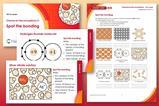Students are likely to come across a number of reactions in their studies
Recognising that a reaction is of a certain type can help the student fit the reaction into one of a limited number of classes.
Task
Scientists classify chemical reactions into different types - such as oxidation and neutralisation.
This exercises provides the equations for a number of chemical reactions.
For each reaction, you are given a word equation, and an equation using chemical symbols:
Magnesium + steam →magnesium oxide + hydrogen
Mg(s) + H2O(g) →MgO(s) + H2(g)
This is an example of an oxidation(magnesium is oxidised) and therefore also of a reduction(water is reduced).
For each reaction, describe the type of reaction. Some of the reactions may be examples of more than one type of reaction.
Some of the reactions may only occur when energy is provided (as heat, or as electrical energy), but this is not shown in the questions.
Use ‘none of the above’ if the reaction does not seem to fit any of the suggestions.
Explain why you have classified the reaction the way you have.
Types of chemical reaction – questions
- nitrogen + hydrogen →ammonia
- N2 (g) + 3H2 (g) →2NH3 (g)
- sodium hydroxide + nitric acid →sodium nitrate + water
- NaOH(aq) + HNO3 (aq) →NaNO3 (aq) + H2O(l)
- copper carbonate + sulfuric acid →copper sulfate + water + carbon dioxide
- CuCO3 (s) + H2 SO4 (aq) →CuSO4 (aq) + H2O(l) + CO2 (g)
- sodium + water →sodium hydroxide + hydrogen
- 2Na(s) + 2H2O(l) →2NaOH(aq) + H2 (g)
- zinc + copper sulfate →zinc sulfate + copper
- Zn(s) + CuSO4 (aq) →ZnSO4 (aq) + Cu(s)
- copper carbonate →copper oxide + carbon dioxide
- CuCO3 (s) →CuO(s) + CO2 (g)
- sodium bromide + chlorine →sodium chloride + bromine
- 2NaBr(aq) + Cl2 (aq) →2NaCl(aq) + Br2 (aq)
- copper oxide + carbon →copper + carbon dioxide
- 2CuO(s) + C(s) →2Cu(s) + CO2 (g)
- methane + oxygen →carbon dioxide + steam
- CH4 (g) + 2O2 (g) →CO2 (g) + 2H2O(g)
- zinc + hydrochloric acid →zinc chloride + hydrogen
- Zn(s) + 2HCl(aq) →ZnCl2 (aq) + H2 (g)
- sodium chloride →sodium + chlorine
- 2NaCl(l) →2Na(l) + Cl2 (g)
- sodium nitrate →sodium nitrite + oxygen OR sodium nitrate(V) →sodium nitrate(III) + oxygen
- 2NaNO3 (s) →2NaNO2 (s) + O2 (g)
Types of chemical reaction – answers
- This binary synthesis reaction, an example of a reduction (nitrogen is reduced) and therefore also of an oxidation (hydrogen is oxidised).
- This is an example of a neutralisation reaction between an acid (nitric acid) and an alkali (sodium hydroxide).
- This is an example of an acid-base reaction, but is not normally called a neutralisation.
- This is an example of an oxidation (sodium is oxidised), and therefore also of a reduction (hydrogen from water is reduced). This could also be considered as an example of a displacement reaction, with sodium displacing hydrogen.
- This is an example of a displacement reaction - with zinc displacing copper from the salt. This is also an example of an oxidation (zinc is oxidised) and therefore also of a reduction (copper is reduced).
- This reaction requires heating, and is an example of a thermal decomposition.
- This is an example of a displacement reaction - with chlorine displacing bromine in the salt. It is also an example of an oxidation(bromide is oxidised to bromine) and a reduction (chlorine is reduced to chloride).
- This is an example of a displacement reaction, with carbon displacing copper from the oxide. This is also an oxidation process (carbon is oxidised) and therefore a reduction (copper is reduced).
- This combustion reaction is an oxidation process (carbon is oxidised) and therefore also a reduction (oxygen is reduced). Some students may feel that hydrogen is also oxidised (as it ‘gains’ oxygen), although from a perspective of oxidation states hydrogen is unchanged.
- This reaction is an example of an oxidation (zinc is oxidised), and therefore also of a reduction (hydrogen is reduced). It may also be a considered an example of a displacement reaction, with zinc displacing hydrogen.
- This reaction requires an input of energy, such as in electrolysis. It is an example of an oxidation process (chlorine is oxidised) and therefore also of a reduction(sodium is reduced).
- This reaction requires heating and is an example of a thermal decomposition. This is also an example of a reduction process (nitrogen is reduced), and therefore also of an oxidation process (some of the oxygen in the nitrate is oxidised to elemental oxygen).
Notes
For the full version of this chapter, see downloads below.
Downloads
Types of chemical reaction
PDF, Size 0.22 mb
Websites
Additional information
These resources have been taken from the book, Chemical Misconceptions : Prevention, diagnosis and care: Theoretical background, Volume 2, by Keith Taber.

Chemical misconceptions
- 1
- 2
- 3
- 4
- 5
- 6
- 7
- 8
- 9
- 10
- 11
- 12
- 13
- 14
- 15
- 16
- 17
- 18
 Currently reading
Currently readingTypes of chemical reaction
- 19
- 20
- 21
- 22
- 23
- 24
- 25
- 26
- 27
- 28
- 29
- 30
- 31
- 32
- 33
- 34
- 35






















































No comments yet